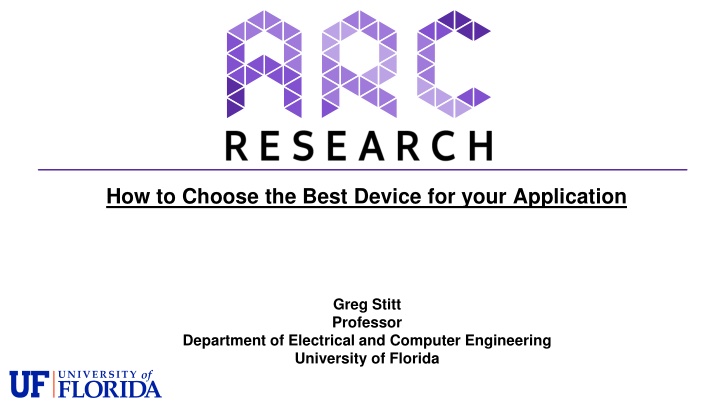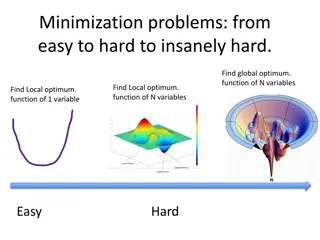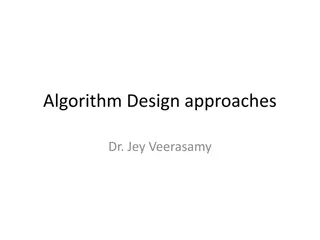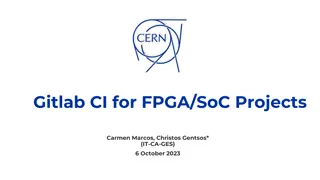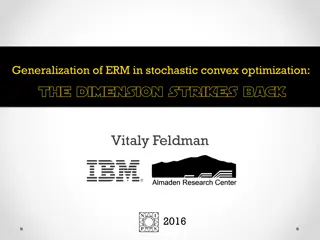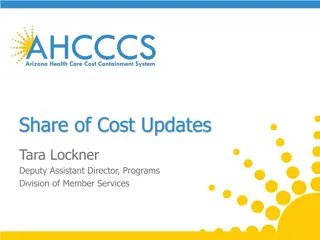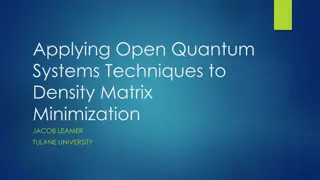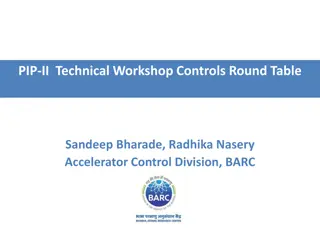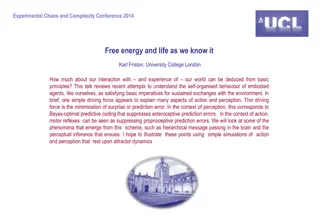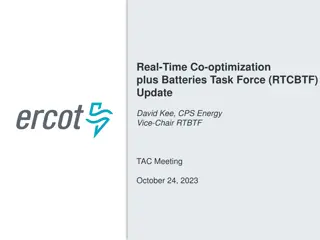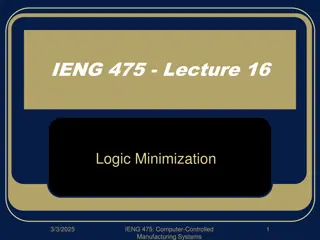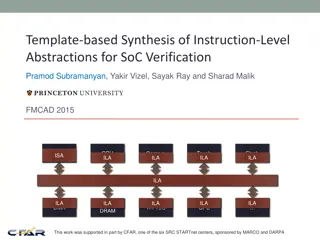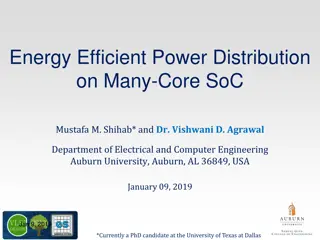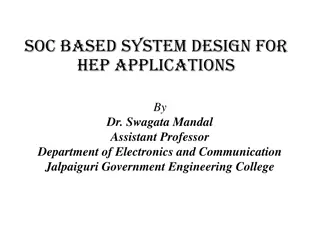Efficient SoC Test Application Time Minimization
With the rapid growth of system-on-chip (SoC) size, minimizing test application time (TAT) is crucial. This presentation discusses SoC test design strategies to reduce TAT, focusing on test access mechanism (TAM) design, test scheduling, and hardware constraints integration. Explore proposed TAM architectures, test components, and flexible designs for optimized test efficiency.
Download Presentation

Please find below an Image/Link to download the presentation.
The content on the website is provided AS IS for your information and personal use only. It may not be sold, licensed, or shared on other websites without obtaining consent from the author.If you encounter any issues during the download, it is possible that the publisher has removed the file from their server.
You are allowed to download the files provided on this website for personal or commercial use, subject to the condition that they are used lawfully. All files are the property of their respective owners.
The content on the website is provided AS IS for your information and personal use only. It may not be sold, licensed, or shared on other websites without obtaining consent from the author.
E N D
Presentation Transcript
How to Choose the Best Device for your Application Greg Stitt Professor Department of Electrical and Computer Engineering University of Florida
Introduction How do you identify the best technology for an application? FPGAs and reconfigurable hardware enable design of digital circuits without fabricating a device Can be used anytime a digital circuit is needed e.g., ASIC prototyping, ASIC replacement When should FPGAs (or any device) be used instead of other technologies? Implementation Possibilities FPGA/GPU Microprocessor ASIC Performance Why not use an ASIC for everything?
Moores Law Moore's Law is the empirical observation made in 1965 that the number of transistors on an integrated circuit doubles every ~2 years [Wikipedia] 1993: 1 million transistors 2007: > 1 billion transistors
Moores Law Moore's Law is the empirical observation made in 1965 that the number of transistors on an integrated circuit doubles every ~2 years [Wikipedia] 2007: > 1 billion transistors Becoming extremely difficult to design this - ASICs are expensive! 2017: > 20 billion transistors $10s of millions https://www.eetimes.com/author.asp?section_id=36&doc_id=1266014
Moores Law Solution: Make billions of transistors into a reconfigurable device - fabricate 1 big chip and use it for many things Area overhead: circuit in FPGA can require 20x more transistors But, that s still equivalent to a 1 billion transistor ASIC Six-core Core i7 (Gulftown) 2010: ~1.2 billion transistors Solution: Make this reconfigurable 2017: > 20 billion transistors
Economic Considerations When should a device be used? Situation 1: when it provides the cheapest solution Depends on: NRE Cost - Non-recurring engineering cost Cost involved with designing application Unit cost - cost of a manufacturing/purchasing a single system Volume - # of units Total cost = NRE + unit cost * volume FPGAs are typically more cost effective than ASICs for low/mid volume applications Typical trends: FPGA: lower NRE, high unit cost ASIC: very high NRE, low unit cost
Application Requirements Microprocessors ( P) have similar cost issues General trend: Very low NRE cost (coding is cheap) Unit cost varies from several dollars to several thousand Wouldn t cheapest microprocessor always be the cheapest solution? Yes, but Often, microprocessors cannot meet performance constraints e.g., video decoder must achieve minimum frame rate Common reason for using custom circuit implementation Different applications and use cases have different constraints Performance, energy, power, cost, size, weight, etc. Device must meet constraints to be considered Must also consider optimization goals (will revisit)
Example FPGA: Unit cost = 5, NRE cost = 200,000 Microprocessor ( P): Unit cost = 8, NRE cost = 100,000 Problem: Find cheapest implementation for all possible volumes (assume both implementations meet constraints) P FPGA Cost 5v+200k = 8v+100k v = 33k 200k 100k Answer: For volumes less than 33k, P is cheapest solution. For all other volumes, FPGA is cheapest solution. Volume 33k
Example: Your Turn FPGA Unit cost: 6, NRE cost: 300,000 ASIC Unit cost: 2, NRE cost: 3,000,000 Microprocessor ( P) Unit cost: 10, NRE cost: 100,000 Problem: Find cheapest implementation for all possible volumes (assume that all possibilities meet performance constraints)
Another Example FPGA Unit cost: 7, NRE cost: 300,000 ASIC Unit cost: 4, NRE cost: 3,000,000 Microprocessor ( P) Unit cost: 1, NRE cost: 100,000 ASIC FPGA Cost Answer: P cheapest solution at any volume not uncommon P Volume
Other Economic Considerations Time to market Huge effect on total revenue FPGAs have faster time to market than ASIC (but still much slower than software) Growth Decline Revenue Total revenue = area of triangle Time Time to market Delayed time to market = less revenue
Misc Considerations Will application have to change or adapt after deployment? Can t change ASIC (actual hardware) Can change circuit implemented in FPGA (virtual hardware) Uses When standards change e.g., codec changes after device fabricated Allows addition of new features to existing devices Allows bug and security fixes Fault tolerance/recovery Partial reconfiguration allows virtual device with arbitrary size - analogous to virtual memory Without FPGA Anything that may have to be reconfigured is implemented in software Performance loss
Optimization Goals and Constraints Goals and constraints have huge impact on device choice High-performance computing Common goal: maximize performance given a power and cost constraint GPU attractive if power constraints met FPGA attractive if GPU consumes too much power, or if goal is to minimize energy costs Embedded systems Common goal: minimize power given a performance constraint High-end GPU might violate power constraints, low-power GPU might be slower than FPGA FPGA often attractive because of low energy and power Data center Common goal: meet throughput constraints while minimizing energy & cooling costs FPGA attractive even if GPU faster due to lower power, energy, cooling costs Examples: Microsoft Catapult, Amazon EC2 F1 13
Application Characteristics Many characteristics can affect best choice of device Common characteristics: Parallelism (types and amounts) and dependencies Arithmetic type (floating point, fixed point, integer, bitwise logic) Branching Memory requirements Sensitivity to memory and I/O bandwidth Data structures and memory access patterns No known equation to automatically determine best device Understanding these characteristics is first step in exploration 14
Architecture Characteristics Device architecture considerations Peak computational throughput GPU: number of cores, clock frequency, on-chip memory, etc. FPGA: # of look-up tables (LUTs), DSPs, embedded RAM, clock frequency, etc. Board architecture often just as important Different boards provide different tradeoffs PCIe accelerators High peak computational throughput But, data must be transferred from CPU into board/device memory Different boards with same accelerator may provide different memory sizes and bandwidths System-on-Chip (SoC) Eliminates PCIe overhead, external memory bandwidth overhead But, limited peak computation throughput Custom boards Example: FPGA on a network-interface card (e.g., Microsoft Catapult) for ultra-low latency network processing 15
Input Size and Characteristics Input can have significant effect on performance and/or energy Small inputs might not use all GPU cores, or amortize PCIe overheads Large inputs might not fit in on-board memory on one accelerator Fastest convolution accelerator and algorithm Lowest-energy convolution accelerator and algorithm Example convolution study* Different devices: GPU, FPGA, multi-core CPU Different algorithms: Time-domain convolution (Time) Frequency-domain convolution (FFT) Some apps have data-dependent performance e.g., different amounts of thread divergence in GPU *J. Fowers, G. Brown, J. Wernsing, and G. Stitt, A performance and energy comparison of convolution on GPUs, FPGAs, and multicore processors, ACM Transactions on Architecture and Code Optimization (TACO) - Special Issue on High-Performance Embedded Architectures and Compilers, vol. 9, pp. 25:1 25:21, January 2013. 16
Common GPU/FPGA Trends GPUs usually provide fastest performance when application: Has large amounts of SIMT floating-point parallelism (loops with fine-grained, independent iterations) Control flow does not diverge (i.e. all threads follow the same path through a function) FPGAs can provide fastest performance when: GPU can t realize peak performance due to SIMT bottlenecks Divergence, stalls, communication overhead, insufficient SIMT parallelism Custom fixed-point precision or bit operations FPGAs usually consume less power than GPU 10s of Watts vs. 100+ Watts FPGAs can use less energy Depends on performance difference GPUs usually much easier to program compared to FPGA Intel OneAPI and DPC++ trying to hide many of the programming differences 17
How to choose a device? Bare minimum approach: 1. Determine architectures that meet all constraints Not trivial, requires performance analysis/estimation - important problem Will study later in semester 2. Estimate volume of application Require understanding of market 3. Determine cheapest solution The best device for an application is typically the cheapest one that meets all design constraints
How to choose a device? More complicated approach: 1. Determine devices that meet all constraints 2. Analyze Pareto-optimal tradeoffs of those devices Includes cost and optimization goals 3. Choose solution that is most attractive for application and use case
Where are FPGAs used? ASIC prototyping (first main market for FPGAs) Validate ASIC on many FPGAs before fabricating ASIC replacement If ASIC is prototyped in FPGA, and FPGA has attractive tradeoffs, just deploy the FPGA IoT, embedded systems, cyber-physical systems e.g., networking, signal-processing, automotive, Advantages FPGAs achieve performance close to ASIC, sometimes at much lower cost (ASIC replacement) High-volume systems still use ASICs (e.g. cell phones) But, ASICs becoming less common due to increasing costs Reconfigurable! If standards change, architecture is not fixed Can add new features (or fix bugs) after production
Where are FPGAs used? Data centers, cloud computing (most recent trend) Intel Xeon+FPGA processor IBM Power9 Microsoft Catapult Originally used FPGA to accelerate Bing searches Used for a variety of machine-learning applications https://www.microsoft.com/en-us/research/project/project-catapult/ Amazon F1 FPGAs integrates into EC2 compute cloud https://aws.amazon.com/ec2/instance-types/f1/ Baidu Uses FPGAs for machine learning Advantages: Low power, ASIC rarely feasible, microprocessor too slow
Where are FPGAs used? High-performance embedded computing (HPEC) High-performance/super computing with special needs (low power, low size/weight, etc.) Satellite image processing Defense applications FPGA advantages Much smaller and lower power than a supercomputer Provide fault tolerance mechanisms
Potential Future FPGA Trends Energy efficient high-performance computing (HPC) Mid 2000s: first appearance of high-end processors with FPGA accelerator boards Cray, SGI, DRC, GiDEL, Nallatech, XtremeData Combine high-performance microprocessors with FPGA accelerators Novo-G 192 Altera Stratix III FPGAs integrated with 24 quad-core microprocessors ~2016: shared-memory coherent systems Intel Xeon+FPGA processor IBM Power9 FPGA advantages HPC used for many scientific apps Low volume, ASIC rarely feasible, microprocessor too slow Lower power consumption Increasingly important Cooling and energy costs are dominant factor in total cost of ownership
Where are FPGAs not used? General-purpose computing (most applications) Problems FPGAs can be very fast, but not for all applications Generally requires parallel algorithms Common coding constructs are not appropriate for hardware Subject of tremendous amount of past and ongoing research High-volume applications Cell phones Machine learning (FPGAs are a competitor, but ASICs increasingly common) Google s Tensor Processing Unit (TPU) https://en.wikipedia.org/wiki/Tensor_processing_unit FPGA vs GPU competition has no clear winner yet GPUs are usually faster, but consume more power FPGAs are usually slower and harder to program, but use much less power and can adapt to exotic new models Gaming, 3D graphics nVidia s GPUs are specialized ASICs
Limitations of FPGAs Peak throughput far below high-end GPUs For any application that maps well onto GPU, FPGA will be at least an order of magnitude slower Programming FPGAs considerably more difficult than software FPGA productivity at least 10x worse than software Generally requires low-level digital-design expertise to perform well Device costs can be prohibitive Largest FPGAs cost ~$10k Symptom of productivity limitations Making FPGAs more usable would lower unit costs via economy of scale
